COVER STORY SIDEBAR
Graduate students -- the foundation of Cornell's future
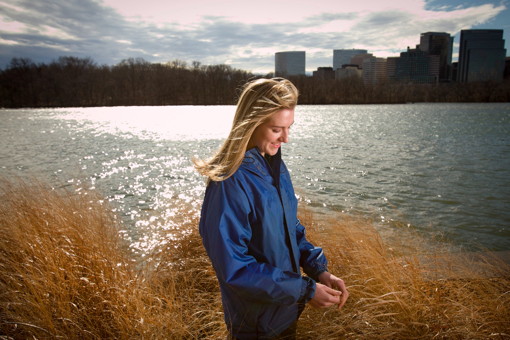
Jillian Cohen along the banks of the Potomac River near Washington, D.C.
Maryland native Jillian Cohen discovered her mission early in life, during a time of public awareness focused on cleaning up the Chesapeake Bay watershed.
"I guess I was ingrained with an environmental ethic when I was 9," says Cohen, a Ph.D. candidate in the field of natural resources. "I learned about the Chesapeake Bay and how interconnected the world is. I've always been a lover of animals, and one of the things I learned is the best way to care for animals is to protect their habitat."
Based in Cornell's Resource Ecology and Management facility, Cohen researches the effects of invasive plant species on amphibians in wetlands, "mostly working outdoors, setting up experimental aquatic communities and seeing how they respond to plants." She has carried out similar experiments at the Montezuma and Iroquois National Wildlife refuges.
Her special committee chair, Bernd Blossey, is an associate professor of natural resources who has an extension appointment working with state-level wildlife managers. Working with him, Cohen says she has "gained a wider view of the importance and implications of my research."
Cohen is one of some 5,200 graduate students at Cornell, of which the majority (3,200) are pursuing Ph.D.s.
Helping to attract top faculty and enriching undergraduate education are among the benefits accomplished graduate students provide, and they are a key factor in Cornell's efforts to be a top 10 research university, says Barbara Knuth, vice provost and dean of the Graduate School.
Within Cornell's system of graduate education, graduate students are not attached to academic departments – instead, they range across fields of study that span traditional departments and colleges, which gives students great mobility across disciplines.
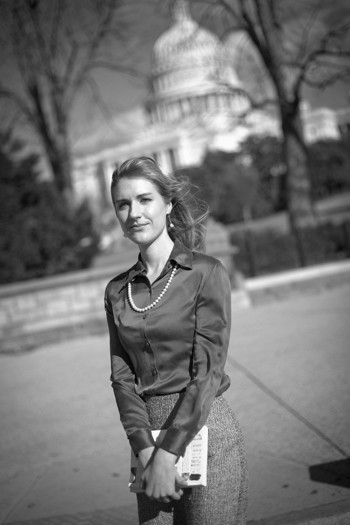
Jillian Cohen near the U.S. Capitol building, where she will be working for a year as a Sea Grant Knauss Fellow. See larger image
"Our Ph.D. programs are very fluid and flexible,"Knuth says. "A student can design his or her program and field of study to meet his or her aspirations."
The Graduate School offers 18 different degrees across a diversity of fields matched by only a few other universities, and had more doctoral research fields (61) participate in the 2010 National Research Council survey than any comparable private institution.
The school reports that 44 percent of its students are women and 45 percent are international students. (Only 10 percent of undergraduates are international.) They come from 69 countries; most prominently China, Canada and Korea. "Applications from China are skyrocketing," Knuth says.
Essential to this educational enterprise is the spirit of collaboration and mentoring of students by more than 1,800 Cornell graduate faculty members. The field and special committee structure for graduate students fosters an environment of cross-disciplinary inquiry to integrate and synthesize knowledge – a benefit many student and faculty researchers agree sets Cornell apart.
"One thing I love most about our department is we have social scientists and natural scientists working together," Cohen says. "I've always benefited from that."
Cohen recently moved to Washington, D.C., to serve for a year as a Sea Grant Knauss Fellow with the U.S. House of Representatives Committee on Natural Resources. She is eager to see how scientists communicate science to policy- and decision-makers, and a chapter of her dissertation will be based on her Capitol Hill experience.
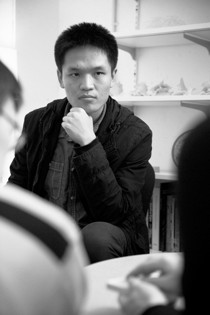
M.Arch. student Simin Wang in Rand and Milstein halls. See larger image
Simin Wang's (M.Arch. '13) undergraduate engineering training helped lead him to National Science Foundation-funded environmental building research with professor Jenny Sabin as co-principal investigator.
Reading blueprints one day at the University of Michigan to determine material costs for a building project, Wang realized he would rather be making the drawings than interpreting them. Architecture and design feed his creative interests, such as photography and drawing, he says, while his engineering and mathematics skills are a benefit in problem-solving.
"It's more than just a sculpture or a drawing I'm rendering," Wang says. "It should be occupiable beauty."
After distinguishing himself in Sabin's fall studio ("Bodies, Waves and Water: Generative Architectures of Change"), he was asked to join her research team. They are in the second year of a four-year project to develop passive-responding building materials that react to environmental conditions such as heat, sunlight, moisture and even touch.
"I really appreciate the diversity of this program," Wang says. "It's not just about architecture or pure design. Some of the faculty are students of [20th-century architectural theoretician] Colin Rowe; some, like Jenny, are really avant-garde. I can get feedback from the old-school faculty. This program also gave me an opportunity to see my background not as a limitation but as a tool."
"Simin has a rare gift," says Sabin, "for applying technology to a design process while expanding the applications for architecture. He seems to navigate both trajectories." On what Wang will contribute to her work, she says, "He's going to be helping us develop a digital tool palette to catalog geometric simulations and help work on problems of scale. His diverse background is really helpful for our research team."
Michael-Paul Robinson is another NSF-funded grad student, an M.S./Ph.D. candidate in chemical and biological engineering. He is hoping to find medical breakthroughs in professor Matt DeLisa's laboratory in Olin Hall, using bacteria to more cost-effectively produce and discover antibodies.
"It's a good environment," Robinson says. "The personalities in the lab really mesh. The common theme in our lab is protein engineering and there's some overlap in our projects. In the future I want to collaborate with some of the other people in the lab."
Funding is at the forefront of graduate education concerns, and the NSF is among the major external funding sources at Cornell.
"The NSF is really big for our field because of the competition," Robinson says. "There is no way you can win the NSF by yourself; so many people in this department helped me [with the proposal]. I went through 20 or 30 drafts."
He also has received a Ford Foundation pre-doctoral fellowship and support from Cornell, including a Colman Family Foundation Fellowship, which provides up to three years of support to underrepresented minority Ph.D. students in the College of Engineering.

Michael-Paul Robinson, a graduate student in chemical and biomolecular engineering, works in professor Matt DeLisa's research group lab space in Olin Hall. See larger image
Cornell is establishing a new donor-supported fellowship program that will allow graduate students, with faculty guidance, to develop mentoring skills. The university also seeks to fully fund every first-year research Ph.D. candidate and to provide fellowship support and financial aid to help every student excel. (See related story, p. 11.)
Working as a teaching assistant (TA) is another side of academic life most graduate students know.
Erika Johnson has taught fluid mechanics to engineering students while working on research for her Ph.D. in environmental fluid mechanics. "Being a TA is a lot of work, but certainly has a lot of rewards – they ask a lot of difficult questions," she says.
Johnson also led seventh- and eighth-graders last year at the "Expanding Your Horizons" conference, an outreach effort aimed at "trying to get girls interested in math and science."
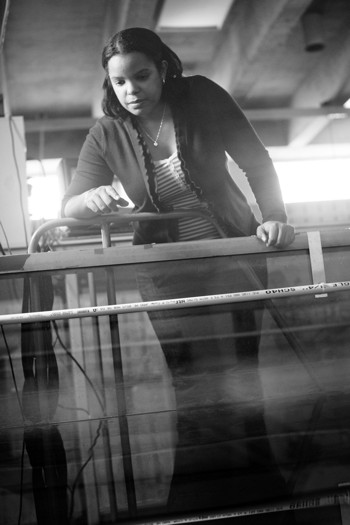
Graduate student Erika Johnson in her Hollister Hall lab, measuring water flow rates. See larger image
Johnson was working for a NASA subcontractor in Florida when she met College of Engineering Dean Lance Collins at a conference. She came to Cornell to further her research on volumetric discharge, or the amount of water flowing in rivers and estuaries. Her work in the field and at Cornell's DeFrees Hydraulics Laboratory will help agencies like the U.S. Geological Survey to conduct more effective and accurate stream monitoring, using remote sensing technology.
"Dean Collins is big on turbulence, and there's a potential for collaboration with people in civil engineering and earth and atmospheric sciences," says Johnson, whose work has been supported by Sloan and Colman fellowships.
Interdisciplinary research-oriented work in science and engineering fields is common at Cornell, but for visual artists pursuing a Master of Fine Arts (MFA) degree it is "a fairly new idea, and more reflective of contemporary practice," says Carl Ostendarp, director of graduate studies in art. Artists produce work "directed by their intentions, regarding the relations between content and the experience they anticipate their viewer having," he says. "It's still very rare in graduate art education to have a program that structures itself as interdisciplinary, which distinguishes our program from peer institutions."
MFA student Piotr Chizinski uses applied research in the arts; among his projects this year is a large installation for Milstein Hall that represents future utopian/dystopian provisions for food, water and shelter. The project, inspired by the Federal Emergency Management Agency, addresses "the great modernist notion that the state will save all, and the question of humanitarian effort," Chizinski says. It has involved extensive research and designing laser-cut 3-D paper models of trailers, water towers and grain storage buildings.
In October 2011, Chizinski received a Jacob Javits Fellowship, usually given to Ph.D. students and rarely to artists. The fellowship allowed him to stay on at Cornell an additional year and "required me to TA one less class, to open my time up to focus on my work," he says.
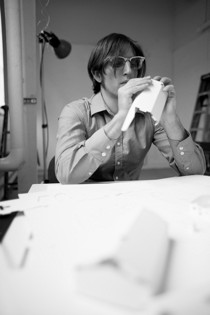
MFA student Piotr Chizinski works in his studio at the Foundry on die-cut paper models for an installation in Milstein Hall. See larger image
Miguella Paula Ann Mark-Carew, a Ph.D. candidate in the field of comparative biomedical sciences, found her way to Cornell through a summer program she attended in 2000 and 2003 as a Dartmouth College undergraduate. "I wanted to pursue research, and knowing I wanted to come back to Cornell, I applied in 2006," she says.
She researches infectious zoonotic diseases, particularly the giardia parasite affecting dairy cattle and canines in New York state and in Trinidad and Tobago. The research will help protect animal populations and safeguard watersheds, including the Delaware County reservoir that provides water to New York City, Mark-Carew says.
"I've always been interested in infectious diseases, and I love animals [but] didn't want to be a veterinarian," she explains. "This, I found, is the best way to do research and better their lives."
Last year, Mark-Carew went to Trinidad and Tobago on a Fulbright scholarship "to look for internal parasites in any mammalian species I could find," she says. After narrowing her study to dairy cattle and dogs, the research led her to initiate the Roaming Dog Assessment Project, an initiative to show the public health implications of having free-roaming dogs in that country. She worked with Cornell veterinary students, the University of the West Indies and two branches of the Trinidad and Tobago SPCA to collect data over a one-year period, counting dogs and gathering stool samples.
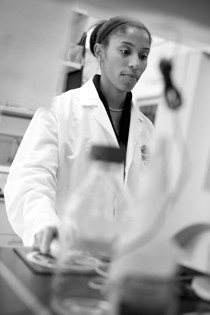
Miguella Mark-Carew is a Ph.D. candidate in the field of comparative biomedical sciences. See larger image
"I was able to make it a collaborative effort, having vet students help me with sample collection," she says.
Opportunities for graduate students to interact with or serve the Cornell community outside of research and teaching settings include the Graduate and Professional Student Assembly, other graduate and professional student associations, and living in residence halls with and advising undergraduates on West Campus.
Cohen served as president of the Natural Resources Graduate Student Association and the Biogeochemistry, Biological Sciences and Sustainability Graduate Student Association, and spent two years as a graduate residential fellow at William Keeton House, which she says "was a wonderful experience. As a graduate student you can become very entrenched in your own research. I got a chance to see the rest of Cornell [and] meet other students from different departments."
Visit http://now.cornell.edu/graduate